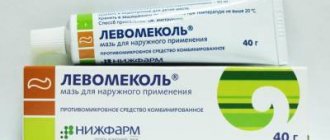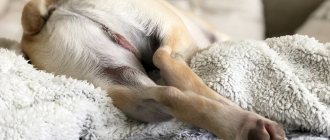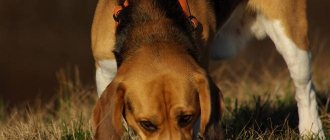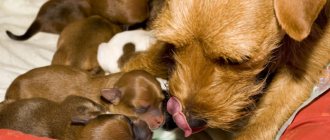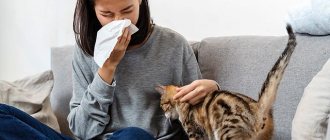Newborn puppies require special care, which increases their vitality. This applies to any breed, be it a Spitz, Yorkshire Terrier or Chihuahua. A person must prepare a nest where they will be in the first months of life. It is important to leave the bitch after giving birth so that her condition returns to normal. Correct behavior by the owner eliminates the risk of problems.
Newborn puppies
Caring for newborn puppies
The first thing the owner must prepare is a warm and dry nest where the bitch should give birth. It is advisable that it be in a separate room. When the puppies were born, the house must be made according to the following rules:
- select a cardboard box so that it does not feel crowded;
- the lid is cut off;
- The internal contents are covered with a mattress or film.
The temperature inside the house should be approximately 30 degrees. It is advisable to install an electric thermometer to maintain the temperature.
Features of development
Immediately after birth, features characteristic of newborns are distinguished:
- the first weeks, when the offspring is born, there is prolonged sleep;
- from the moment of birth, the offspring is deaf, blind, and lacks the ability to walk.
At 2 weeks your eyes should open. Initially they are blue, cloudy, then darken. It is necessary to keep the eyes clean, removing purulent discharge. The ear canals open on their own by 3 weeks.
At 4 weeks teeth appear. But for each breed the period is individual. This leads to a limitation of breastfeeding; it is time to introduce complementary foods.
Attention! Many people, when caring for newborn puppies, note that they shudder in their sleep; this is a normal reaction; voluntary muscle contraction occurs.
Breast-feeding
Helping your puppy go to the toilet
Did you know that newborn puppies cannot walk on their own? The mother of the puppies, to help them urinate and defecate, licks their respective areas after they eat. If mom is not around, then you must help them with this yourself. You can do this by massaging their anal area with a soft cloth soaked in warm water. Your veterinarian can show you how to do this properly until your puppy can walk, which will be approximately 3-4 weeks after he is born. Next, you should start worrying about toilet training your puppy.
What to do after the birth of puppies
Not every owner knows what to do with puppies after birth. If they pass naturally, the person does not interfere. The babies are left near their mother and are provided with warmth and comfort. It is forbidden to separate them, this will worsen lactation and maternal instinct in the bitch. Babies should drink colostrum fluid, which contains antioxidants, proteins, vitamins, and immunoglobulins. This also applies to large breeds, such as the German Shepherd. Don't be afraid that she will run over the kids.
Additional Information! With rare exceptions, the newborn may not be active in sucking. To prevent his vital functions from deteriorating, artificial feeding with expressed milk or formula is used.
Licking puppies
Newborn puppies: care in the first days of life
When the bitch begins to leave the den 3-5 days after giving birth, the owner needs to inspect the offspring.
- Trimming nails. Immediately after birth they are curved and sharp. This can cause harm if you move awkwardly.
- Inspection of stool. If a disease develops, they contain blood and pus.
- Check for dehydration. Lightly pinch the newborn's skin and release it. If there is no dehydration, it will quickly smooth out. Otherwise, additional soldering is required.
- Eye opening. From this moment on, it is necessary to secure the shelter so that the kids do not accidentally harm themselves when the puppies begin to walk on their own. Additionally, it may be necessary to remove pus if the dog does not lick it.
Interesting! Mostly mom does all the work. A person must ensure that the surrounding area is safe.
Bitch after giving birth
Carefully examine the bitch after giving birth. Pay attention to the following criteria:
- there should be milk in the mammary glands, but there should be no stagnation, which increases the risk of mastitis;
- postpartum discharge should be free of blood and pus, which indicates pathology (dead puppy in the birth canal, bacterial infection);
- The dog’s body temperature is normal - 38-39 degrees, hyperthermia develops due to inflammation;
- behavior is stable, mother feeds and licks the puppies, warms them (aggression, anxiety, excessive weakness are a sign of illness).
If there are deviations in health, contact a veterinarian. Do not give medications on your own.
Nursing dog and proper care
During the period when puppies can live exclusively on mother's milk, a nursing dog needs support and attention, because she must feed them so that they develop normally and double their weight in the first week of life, or even gain more. No earlier than 15-20 hours after whelping, the bitch is fed for the first time. The first three days after whelping, you need to be especially careful in feeding your dog and it is important to decide what dog food to buy.
If immediately after birth you begin to give food to a nursing dog as usual and to the fullest extent, you can cause severe stomach upset and very severe diarrhea not only in her, but also in puppies, which is especially unpleasant, because the babies will begin to lag behind in weight, will be lethargic and whine all the time. Fresh water must certainly be available to her at any time and in any quantity.
During the first three days, a nursing dog should not be given solid food, but only liquid dietary food; only after this period can you give it some raw meat. If the birth was difficult, it is good to add glucose to your food. The first days after giving birth, a nursing dog has loose stools, so the dog needs to restore proper bowel function as quickly as possible, for example, with rice porridge or cottage cheese. After three days, you can switch to your normal diet if your stool has improved. Usually they go back to feeding four times a day, but no less! While feeding puppies, the bitch should receive plenty of fluids.
Milk tea is strong tea with milk, sweetened with honey (or with condensed milk). The brew must be fresh. Milk in its pure form is undesirable; various lactic acid products are better.
After giving birth, a nursing dog will experience discharge for 7-10 days - initially copious and bloody, later it becomes lighter and thinner.
Reasons for concern when caring for a nursing dog
The following signs should alert you to this. – Discharge of pus; – the appearance of a putrid, hydrogen sulfide purulent odor instead of the usual one inherent in the bitch who gave birth; – copious bright red discharge or blood; – temperature rise to 40-41.5 degrees; – severe anxiety; – the dog’s refusal to feed.
In these cases, you should call a veterinarian. For several days after giving birth, a nursing dog may experience a slightly elevated temperature (up to 39.5 degrees). If you feel generally good and have an appetite, this should not cause concern.
During feeding, calcium is excreted from the bitch's body along with milk. Therefore, it is necessary to give mineral supplements in sufficient quantities so that the bitch does not go bald after puppies, her back does not bend, so that feeding does not negatively affect your dog’s teeth and her offspring, and most importantly, so that there is no postpartum eclampsia.
The nipples should be examined regularly, and the fur on the belly should be kept short at all times. If scratches and redness of the skin around the nipples are noticeable, you need to tame the claws on the baby's front paws. We already said above that starting from the age of one week, puppies need to have their nails trimmed. Often dog owners complain that the puppies are only two weeks old, but the nursing dog already has a feeling of disgust towards them and refuses them. The whole point is that puppies scratch their mother’s belly with their claws. If the bitch's nipples show redness from puppy claws, lubricate the belly and nipples of the nursing dog with emollient cream or synthomycin liniment 5%, and then wipe with a pale pink solution of potassium permanganate. After this, everything will quickly return to normal. Cracked nipples in a nursing dog
Nursing dogs, especially those whelping for the first time, often have cracked nipples. The dog experiences excruciating pain during feeding, and may even refuse to feed. There have been cases when a bitch lost milk due to constant pain. In addition, mastitis can result from cracked nipples. Therefore, when they appear, take action immediately, without delaying until later. After each feeding, wash the nipples (always not only the affected ones) with a weak solution of potassium permanganate and lubricate the cracks with Kalanchoe juice or pharmaceutical ointment with Kalanchoe ointment, but do not let her lick the medicine from the nipples and sit with her for half an hour. You can alternate Kalanchoe with sea buckthorn or rosehip oil. Then rinse the nipples with a slightly pink solution of potassium permanganate. If after five or six days of such treatment the nipples do not begin to heal, you need to contact a veterinarian - you may need stronger remedies.
Constantly check whether a nursing dog has lumps in the nipples, the first signs of incipient mastitis (inflammation of the mammary glands). More often, milk stagnates in the front nipples, especially if there are few puppies and they are content with two pairs of the most comfortable and milky rear nipples.
If you find a lump, try to express milk from the nipple closest to the hardened lump. If expressing fails, give the dog one No-Spa tablet, after 30 minutes give an injection of oxytocin and immediately begin expressing. If the lumps do not decrease, but on the contrary gradually increase in size, harden, the skin over them becomes hot and red, and the dog’s temperature rises, consult a doctor.
Eclampsia in a nursing dog
In medicine, eclampsia is defined as “a convulsive attack without loss of consciousness that occurs during pregnancy or childbirth.” Most often, eclampsia appears in pregnant bitches up to the 21st day after whelping. This condition is associated with low levels of calcium and possibly glucose in the blood, although the exact cause remains unclear. Eclampsia occurs even when the animal receives the required amount of calcium from food.
It manifests itself like this: a nursing dog becomes restless, hides from the light, and does not pay attention to the puppies. If the dog is not treated, sudden muscle spasms occur, the bitch becomes extremely agitated, often squeals and barks, or may become depressed. Body temperature is usually extremely high (often above 40.5 degrees). If convulsions are allowed to continue, the dog will gradually weaken and enter a state of flaccid paralysis, severe comotosis and death will occur.
Eclampsia is a very dangerous disease and requires emergency veterinary care. Before the doctor arrives, you can help your dog by giving an intramuscular injection of calcium gluconate (5 ml of a 10% solution) and magnesium sulfate (4 ml of a 25% solution). You can give the bitch 20 drops of Volocordin or Corvalol internally. Sometimes relapses are possible, so further treatment is necessary.
I RECOMMEND WATCHING:
Articles on the topic
- Features of pregnancy in dwarf dog breeds
- How to feed a pregnant dachshund
- Feeding the puppy after weaning
- Maintenance and feeding of puppies during the suckling period
- Preparing for breeding dogs
- Mating dogs.
- Pregnancy
- Breeding bitch
- Stud dog
- Dog mating
If the dog does not feed the babies
If your dog gives birth, it is important to know what to do next. There are times when a bitch refuses to breastfeed. The owner must use artificial nutrition for the babies to survive.
What to feed
Veterinary pharmacies sell special mixtures to replace bitch milk. The following companies are used:
- Lactazor;
- Royal Canin Mini;
- Welpenmilch.
Each product comes with instructions for diluting the powder. You can use homemade ingredients if a similar mixture is not available:
- boiled goat milk;
- glucose solution in water;
- a mixture of milk and chicken yolk.
Professional breeders prefer to use a mixture that contains all trace elements, minerals, and vitamins.
How to feed
For feeding you will need a syringe with a rubber nozzle, a pipette, and a bottle with a small nipple. The mixture is given every 3 hours, it should be heated to 38-40 degrees.
How many
The newborn is pre-weighed to find out how much formula he will need. Usually 1 ml per feeding is enough to keep babies full. From 2 weeks the volume is increased to 10 ml.
Interesting! In the first week, puppies may lose weight, but this is normal.
How often
For healthy, strong puppies, feeding every 3 hours a day is sufficient. If they are low weight, the number of feedings is increased to every 1.5 hours.
Lure
In the first 3 weeks of life, breastfeeding is carried out. The owner must ensure that babies latch onto the nipple when eating. The first complementary feeding begins at 3-4 weeks. The following rules apply:
- small portions of food once a day, observing the baby’s reaction and feces;
- By week 6, add 1 more complementary food.
For newborn puppies, the following products are allowed to be added in small quantities:
- turkey meat, chicken, veal;
- eggs;
- dairy products;
- ocean fish without bones.
From 1.5 months, babies should eat 6 times a day in small portions. Three of them should be meat, the rest - dairy. After this point, cereals are added.
Diet during pregnancy
A lot depends on how you feed your pregnant pet: the health of the puppies, the well-being of the expectant mother and, of course, the functioning of her internal organs.
- Don't let your dog eat food today that you prepared yesterday. All food should be as fresh as possible, especially meat dishes. Food poisoning is scary not only because of the disgusting health of the pet, but also because of the death of the babies.
- Be prepared for the fact that your pet’s tastes will change dramatically: there is nothing to worry about, because a pregnant woman also often radically changes her preferences. The mechanism is the same here.
- If you prefer natural food, be sure to purchase special vitamins on the recommendation of your veterinarian. If you have made a choice in favor of dry food, then additional complexes are not needed (only in the case of special doctor’s prescriptions), otherwise this can lead to the development of various pathologies.
- Do not increase the portion of food in the first 5 weeks of pregnancy, but provide liquid so that the pet does not need it at any time of the day. Already in the second half of gestation, the total number of calories consumed per day can be increased by about 25-30%.
- In the second half of pregnancy, it is important to increase the number of feedings per day from 2 to 5 times, but the portions themselves will have to be reduced somewhat, otherwise regurgitation may occur.
How to properly care for puppies in the first week of life
After the birth of the babies, the owner must monitor the behavior of the mother and newborns. She must cover them and provide access to breastfeeding. If this does not happen, the person warms up the box on his own and uses artificial feeding.
If the bitch has developed a maternal instinct, she performs further actions independently. With the help of licking, it removes amniotic particles, pus from the eyes, and stimulates the digestive tract. The owner must ensure peace, correct room temperature, and the availability of diapers.
Newborn blindness
Determination of gender
An experienced veterinarian will be able to accurately determine the sex within a week after birth. Everyone else will have to wait a little longer until the genitals become more visible.
Males and females are distinguished by the structure of the genital organs and behavioral characteristics, so after 8-10 weeks there will be no problems with sex determination. Boys will already have clearly visible penises, while girls will have a fully formed vulva. However, if you cannot wait that long, the determination can be made earlier, at about 1 month.
Inspection is carried out in compliance with safety precautions:
- Wash and dry your hands thoroughly and warm them.
- Take the puppy and observe the mother's reaction. If she objects aggressively, it is better to carry out the procedure later.
- Gently turn the dog over onto his back. If the puppies are large, then it is better to carry out the operation on a warm towel; if they are small, then it is possible to carry out the operation by weight in the palm of your hand.
- Pay attention to the genital area. Representatives of both sexes have one bulge - the umbilical cord, but just below there will be either a developing penis, which looks like a small seal and tubercle, or a vulva, that is, a second hole.
The easiest way to distinguish newborns is by the number of holes in the lower abdomen. Boys have one, and girls have two.
Proper care for puppies at 1-2 months
By this time, the babies began to move around and eat solid food. When puppies begin to defecate on their own, it is necessary to accustom them to a diaper so that they do not relieve themselves in other places. Mark a place for the toilet.
The amount of complementary foods is reduced to 3 times a day. They get vaccinated. The children are gradually taken outside. After this point, you can make documents for each puppy.
First feeding
Caring for a pregnant dog
Getting rid of worms
Getting rid of worms is one of the most important points in caring for a pregnant dog. The whole difficulty lies in the fact that it is necessary to get rid of worms within the first 3 weeks after conception. If you missed this deadline, you cannot do this in the future, as the puppies may die as a result. Be sure to consult with your veterinarian, who will tell you what to do next.
the washing up
Experts strongly do not recommend bathing a dog already in the 5th week of gestation.
This is additional stress, which, of course, should be avoided if possible. In addition, washing can cause colds and hypothermia. But what to do if bathing a dog is not a whim, but a necessity? In this case, firstly, all windows in the house must be closed to avoid drafts. Secondly, after washing, the pet’s fur must be dried immediately. Don't let your pregnant dog lie on the cold floor after bathing. Make sure that the coat is really completely dry, and only then think about taking the dog outside or ventilating the room. Walking with the dog is allowed only the next day after water procedures.
Cleaning teeth and ears
During the period of bearing puppies, it is important to monitor the condition of the dog’s teeth and ears. Take the time to remove plaque and clean out your ear canals to eliminate all sources of bacteria.
Walks
During pregnancy, no one canceled walks with the animal.
On the contrary, the need for walking increases, since activity must be maintained. You will not harm your pet's health if you follow simple rules: do not walk your dog in places with large crowds of people and other animals. In addition, try to choose quiet, secluded places for walks (park, forest belt). In the first 5 weeks of pregnancy, you can maintain activity, it is only important to avoid excessive overload, sudden jumps and, of course, hitting your stomach on the ground. In the next period of pregnancy, it is worth moderating your ardor, although the pregnant dog itself is unlikely to want to jump and jump. Do not stop walking under any circumstances, no matter how much the animal itself wishes to do so. Try to walk especially a lot on warm and sunny days.
Behavior of puppies in the first few weeks after birth
Raising puppies from birth should be done in stages, according to rules, so that they remain healthy. Their behavior changes as they grow older, according to periods:
- 1 week - constant sleep;
- 2-3 weeks - eyes open, but the muscular frame is not strong enough to move around the entire territory;
- 4-6 weeks - babies move actively, consume breast milk and complementary foods, and can play with each other.
Attention! The owner must monitor whether there are weak individuals among the newborns. They require special care and frequent feeding.
Possible problems
Immediately after birth, problems may arise that the owner should pay attention to:
- one of the babies may turn out to be weak and underweight;
- refusal of the mother to breastfeed or the offspring;
- increased body temperature in the mother and babies, which may mean the development of complications and infectious diseases;
- suppuration of the eyes of the offspring;
- one offspring could be stillborn, but not emerge through the birth canal, which would cause a sharp deterioration in the dog’s well-being.
To resolve such problems, it is better to contact a veterinarian. He will accurately diagnose and prescribe treatment.
Pus and redness of the eyes
Immediately after the birth of pug puppies, Jack Russell, Yorkie, dachshund and other breeds, the owner must take care and care for them and the mother. It is important to use the first feeding correctly and observe the temperature regime. When puppies begin to walk after birth, it is necessary to fence off the den from dangerous objects. If preparation and subsequent care are carried out correctly, the babies will grow up quickly, each of them will be viable.



